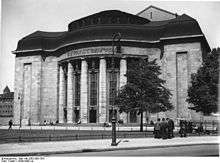Volksbühne

The Volksbühne ("People's Theatre") is a theater in Berlin, Germany. Located in Berlin's city center Mitte on Rosa-Luxemburg-Platz (Rosa Luxemburg Square) in what was the GDR's capital.
The Volksbühne was built during the years 1913 to 1914 and was designed by Oskar Kaufmann, with integrated sculpture by Franz Metzner. It opened on December 30, 1914[1] and has its origin in an organization known as the "Freie Volksbühne" ("Free People's Theater") which sketched out the vision for a theater "of the people" in 1892. The goal of the organization was to promote the naturalist plays of the day at prices accessible to the common worker. The original slogan inscribed on the edifice was "Die Kunst dem Volke" ("Art to the people"). During World War II, the theatre was heavily damaged like much of the rest of Berlin. From 1950 to 1954, it was rebuilt according to the design of architect Hans Richter.
Frank Castorf became director in 1992. In 2015 the City of Berlin announced that Castorf will be replaced by Chris Dercon in 2017.[2][3] The theater was named the most exciting stage in Germany („aufregendste Bühne Deutschlands“), attracting much press attention and establishing a reputation as one of the most provocative and experimental major theaters in contemporary Germany.
References
- ↑ "100 Years of Volksbühne in Berlin" In: Berliner Morgenpost vom 30.12.2014
- ↑ "Tate Modern Director, Chris Dercon, to Step Down". New York Times. Retrieved April 28, 2015.
- ↑ Oltermann, Philip (1 December 2016). "Revolt at the Volksbühne: behind the scenes at Berlin's troubled theatre". The Guardian. Retrieved 4 December 2016.
External links
| Wikimedia Commons has media related to Volksbühne Berlin. |
Coordinates: 52°31′37″N 13°24′43″E / 52.52694°N 13.41194°E